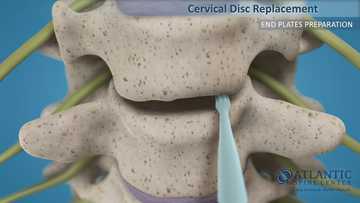Endoscopic Spine Surgery
Diagnostic Procedures
Pain Management Procedures
Traditional Spine Fusion Surgeries
Mini Spine Fusion and Spine Disc Replacement
Cervical Disc Replacement Surgery — Indications, Technique, and Technical pearls
CADR stands for cervical artificial disc replacement. It is used to remove a damaged cervical disc completely through a small incision in the neck and replace it with an artificial disc. It is needed when the space between the vertebrae is too narrow, which causes pain, weakness or numbness, and the patient doesn’t respond to other treatments. Loss of this space is quite common and happens due to cervical disc degeneration, or wear and tear with age. Some symptoms include pain in the neck, or pain traveling down into shoulders and arms, weakness or numbness in the arms and shoulders, or a patient may experience neck stiffness and headaches.
Such a neck surgery targets the removal of a cervical disc and replaces it with an artificial disc. This is a new method that was recently approved by the FDA. It has a number of benefits, including less stress on the remaining vertebrae, which was increased after a traditional disc fusion surgery.
multimedia
CADR Can Be Used to Treat These Conditions
This type of surgery is recommended for:
- Cervical Disc Herniation
- Cervical Radiculopathy
- Cervical Degenerative Disc Disease
Symptoms of cervical disc degeneration
Neck pain or pain that goes down one arm are the signs of cervical disc degeneration, which is one of the most common indications for back surgery.
Among other symptoms are unpleasant sensations in arms, shoulders and neck. You may experience the feeling of tingling, weakness or numbness.
Patient indications for cervical disc replacement
Usually, the first treatment option includes conservative treatments that involve physical therapy and pain medication. If such a treatment doesn’t ease the symptoms, the patient can be considered a candidate for cervical disc replacement. Prior to surgery, the patient should be in good general health, no allergies to metals, and have at least one herniated or compressed cervical spine disc.
Efficacy of cervical artificial disc replacement surgery
In most cases, a patient has to stay in the hospital for 1-2 days after the cervical arthroplasty. Even though this surgery is still considered a new procedure, it was repeatedly proven to be quite safe and effective for neck and arm pain, if the pain was caused by a compressed nerve root or spinal cord. Pain is relieved after the surgery and the result lasts for years.
Usually, the efficacy of the cervical artificial disc replacement surgery is compared to the anterior cervical discectomy and fusion (ACDF) surgery. The second option is a more traditional surgery to treat spinal cord compression. Both surgeries remove the damaged disc, but in the ACDF the remaining discs are fused together, while in CADR the damaged disc is replaced with an artificial one. The replaced disc helps distribute pressure on the vertebrae and maintain a more natural neck motion. Also, it cuts the risk for the adjacent vertebrae to develop degenerative disc disease. Moreover, ACDF is associated with a longer recovery period and more potential complications.
Risks of cervical disc replacement
Disc arthroplasty is considered relatively safe, but it still has several possible risks and complications. Before this procedure, discuss the risks and benefits of the surgery in your case, especially compared to more traditional options. Disc replacement is still a new type of surgery, so there is little data on long-term effects and risks.
Among the potential risks are excessive blood loss and a reaction to anesthesia or the implant materials. Also, a patient might need an additional surgery or experience symptoms such as pain, numbness or tingling, or paralysis. Infections, as well as implants or incision issues, can happen during or after the surgery.
Recovery after surgery
Usually, a person needs to stay in the hospital for a day or two after the surgery to recover from anesthesia. The recovery is quite fast, as the size of the incision is rather small. But, you might need to wear a protective collar or other neck support. Also, your doctor may recommend physical therapy. Typically, a person can return to their normal diet in a day after the cervical disc arthroplasty, and to some physical activity in a couple of days. But you might need to rest for 4-6 weeks before returning to work and normal life after cervical disc replacement.
After the surgery, a patient typically has several postoperative X-rays to see if the spine is aligned and the new implant is in the proper position.
